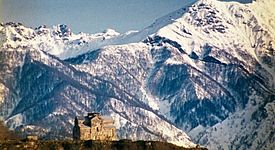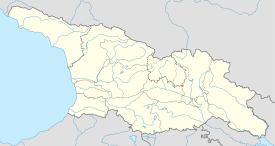Bedia Cathedral
| Bedia Cathedral ბედიის მონასტერი |
|
|---|---|

Bedia Cathedral and the Caucasus Mountains in the background.
|
|
| Basic information | |
| Location |
Bedia, Tkvarcheli District, Agubedia, Ochamchire Municipality, |
| Geographic coordinates | 42°46′02″N 41°40′08″E / 42.7672°N 41.6689°ECoordinates: 42°46′02″N 41°40′08″E / 42.7672°N 41.6689°E |
| Affiliation | Georgian Orthodox Church |
| District | Tkvarcheli District |
| Region | Caucasus |
| Country | Georgia |
| Architectural description | |
| Architect(s) | Avtandil Shulavreli |
| Architectural type | Domed cruciform plan |
| Architectural style | Georgian; Cathedral |
| Groundbreaking | Late 10th century |
| Completed | 999, during the reign of King Bagrat II of Abkhazia |
| Dome(s) | 1; the dome and drum are collapsed |
Bedia Cathedral (Georgian: ბედიის მონასტერი) is a medieval Georgian Orthodox cathedral located in Bedia, in the Tkvarcheli district of Abkhazia (or Ochamchire Municipality according to the Georgia's subdivision), a disputed region on the Black Sea coast.
Bedia Cathedral was originally built at the close of the 10th century and consecrated in 999 on the behest of King Bagrat II of Abkhazians, who would go on to become King of the Georgians as Bagrat III and who was interred at the church after his death. The extant edifices, however, date back to the 13th-14th centuries and include a domed cruciform church, a belltower resting upon the northern narthex and the ruins of an old palace. The southern wall of the main church contains fragments of contemporary murals, including the portraits of Bagrat II and the representatives of the Dadiani noble family of Georgia.
In the Catholicate of Abkhazia, Bedia was the centre of a diocese and the seat of a Bishop. In the 17th century, services were ceased, but resumed from the second half of the 19th century onwards.
As evidenced by the historic sources, complex was erected in late 10th c., ca. 999, by Bagrat III Bagrationi, the first king of the united Georgian kingdom, who, as stated by the Georgian chronicler, “made an Episcopacy out of it”. The church of the Virgin, erected in the centre of the monastic courtyard, is the main church of the monastery. To its west is the two-storied palace of metropolitans of Bedia. The church of the Virgin was considerably transformed on the turn of the 13th c. to the 14th c. and in the 15th c. The bell-tower is a 12th-14th cc. structure, while the Episcopal palace was built in the 16th c. by Anton Zhuanisdze, Georgian Metropolitan of Bedia. Three layers of mural decoration are preserved in the church interior, which date back the 10th-11th, 13th-14th, and 16th-17th cc. bell-tower, ground floor of which functions as a gate to the monastery, while from the south the two-storied Episcopal palace is adjoined. Facades of the Bedia church, its interior murals and ecclesiastic objects preserved lapidary inscriptions in Georgian asomtavruli (uncial) script, bearing evidences on the construction, renovation and restoration of the church. Over the centuries, Bedia Episcopal See was one of the most significant ecclesiastical, cultural and educational centre of Georgia. Archbishop Anton Zhuanisdze had established a rich library in the Bedia monastery, where old manuscripts were renovated and restored, theological treatises were translated and the library collection was enriched with new manuscripts. Bedia monastic complex is a symbol of unity and indivisibility of Georgia. Bagrat III, the first king of the united Georgian kingdom and his mother, Queen Gurandukht are buried in Bedia.
...
Wikipedia

